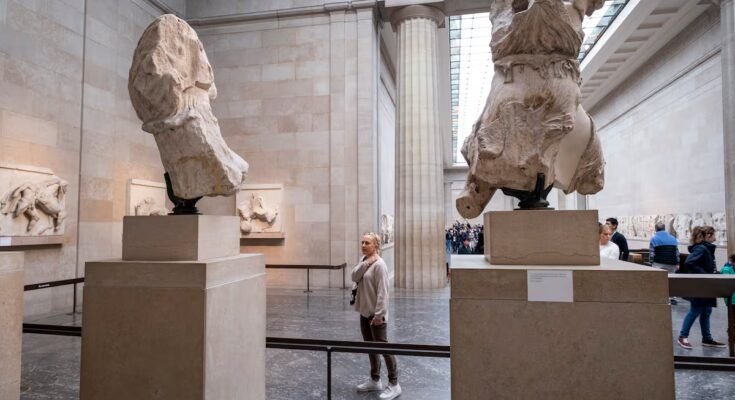The diaspora of the Parthenon Marbles, and in particular the collection of Elgin (the diplomat who, with the permission of the Ottoman Empire, took more than half of the statues between 1801 and 1805), now in the British Museum, provides an important turning point to the modern history of the Parthenon. From the moment the first shipment was shown to a privileged few in 1807 (in a shed at Elgin House on the corner of Park Lane in London), the marbles attracted as much attention as the Parthenon itself, if not more. (…) As expected, Mrs Siddons, the famous actress of the moment, shed a tear (histrianatically) when she first saw the figures emerge from the gables of the temple in the Park Lane shed. John Keats captured its spell on paper in the form of a sonnet entitled See the Elgin Marbleswhen he visited the sculptures in 1817, shortly after their transfer to the British Museum, and presumably incorporated some vignettes taken directly from the frieze into his even more famous Ode to a Greek Urn.
On the other hand, Goethe celebrated the British government’s decision to purchase the collection from Elgin as “the beginning of a new era for great works of art.” One of the most mentioned reactions was that of the sculptor Antonio Canova, who refused the coveted marble restoration job that Elgin had offered him on the grounds that “it would be a sacrilege on his part or on anyone else’s part to try to touch them with a chisel”. However, it is not often noted that he came up with this elegant and flattering denial towards his undoubtedly pressing client a few years before seeing the collection with his own eyes. (…)
The Elgin Marbles were the first examples of sculpture from what was believed to be the golden age of art that most Britons could see with their own eyes. While some critics were enthusiastic, others didn’t like what they saw too much.. They thought many of the figures were disappointingly beat up; some (especially the metope panels) seemed of poor quality and almost none reached the expected level of “sublimity”. (…)
Many visitors felt that the sculptures were simply “wrong” in the British Museum. This was partly due to the feeling that works of art created for the radiant Athenian sun were inevitably overshadowed by exposure in the bleak environment of Bloomsbury: the English climate outside and the whispering tone adopted by the troops of dutiful visitors inside. For her part, Virginia Woolf preferred the “hairy, ruddy bodies” of Greek tragedy to those that delicately “rested on granite plinths in the dark corridors of the British Museum”, while Thomas Hardy put into the mouths of the marbles themselves the lament of having “been transferred into the darkness / of this dark room” in his poetry Christmas at Elgin Hall. However, these exhibition-related questions often ended up diluted into what would become the world’s longest-running cultural controversy: Was it right for Elgin to remove the marbles from their original location? Was it right that they were sent to Britain? And does justice demand that they be brought “home”? In short, was Byron (who harshly criticized the looting of Greek sculptures) right?
These debates have been going on for two hundred years. Insults and copious tears were exchanged, most notably from the formidable Greek Culture Minister Melina Mercouri, who cried on camera during her visit to the marbles of the British Museum in 1983. Damaging arguments were made on both sides. Britain has been parodied as a recalcitrant colonial power, desperate to retain its cultural spoils as a replacement for its lost empire; Greece is a new Balkan republic, a peasant state that cannot be entrusted with the custody of an international treasure.
Politicians have jumped on and off the bandwagon. Successive Greek governments have found in the loss of the Parthenon sculptures a timely symbol of national unity and in petitioning for their return a low-cost and relatively risk-free campaign. After long delays, a new museum was built in Athens with space reserved for his return. With the same diligence, successive British Labor governments have forgotten the hasty promises, made by the opposition, to return the marbles to Athens as soon as they came to power.
Meanwhile, in the crossfire, all sorts of crucial questions about cultural heritage have emerged: Who owns the Parthenon and other important monuments? Should all cultural treasures be repatriated or should museums be proud of their international heritage? Is the Parthenon a special case? and if so, why? Whatever the assumptions and wrongs of this dispute (and they are more difficult to judge than advocates on both sides would have us believe), the never-ending controversy has had a clear effect. It has helped keep the Parthenon at the top of our cultural agenda. Not without help, of course.
The Parthenon belongs, as we have already seen, to this small group of monuments whose historical importance is covered by the reputation of “being famous”. When we visit it in Athens or the British Museum, we are not just looking for a classical Greek work of art; After all, there are numerous classical temples larger and better preserved than this one that have never attracted so much attention. We’re also following in the footsteps of everyone who has visited before (which is why we want to take our photos there…) and paying homage to a symbol that has been written into our cultural history, from Keats, through Freud, to Nashville.
But in the case of the Parthenon there is yet another dimension. We are faced with a monument disputed for generations, which inflames passions and provokes government intervention. In other words, it has the added merit of being something worth arguing about. It is difficult to resist the uncomfortable conclusion: if it had not been dismembered, the Parthenon would never have had half its fame.



